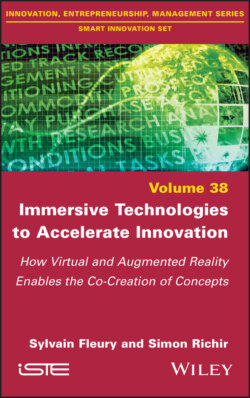Immersive Technologies to Accelerate Innovation

Реклама. ООО «ЛитРес», ИНН: 7719571260.
Оглавление
Simon Richir. Immersive Technologies to Accelerate Innovation
Table of Contents
List of Illustrations
Guide
Pages
Immersive Technologies to Accelerate Innovation. How Virtual and Augmented Reality Enables the Co-Creation of Concepts
Foreword
Acknowledgments
Preface
Introduction
1. Innovation Management: Issues and Key Points for a Vital and Strategic Process
1.1. A question of survival
1.1.1. The example of Blockbuster Video
1.1.2. A regime of intensive innovation
1.1.3. From creativity to innovation
1.1.4. Equipping ourselves to innovate better
1.1.5. Modeling innovation at the company level
1.2. The blue ocean strategy
1.3. Open innovation
1.3.1. The two types of open innovation
1.3.2. The example of the MayAM challenge
1.3.3. Collaborative innovation
1.3.4. Crowdsourcing
1.3.5. The lead user
1.4. Technical and human issues from ideation to design
1.4.1. The sketch as a reflective process
1.4.2. Types of representation
1.4.3. Conditions for the effectiveness of sketches
1.4.4. The phases of ideation
1.4.5. The right tools at the right time
1.4.6. A growing variety of tools
1.4.6.6. Table, touch pad and pen
1.4.6.6. Augmented reality on smartphones and tablets
1.4.6.6. Virtual reality sketches
1.4.6.6. Model generation by artificial intelligence
2. Creativity and Cognition: Factors and Biases of Mental Processes Involved in Creative Activities
2.1. The creativity process. 2.1.1 The Wallas model (1926)
2.1.2. The GENEPLORE
2.1.3. Analogies
2.2. The factors of individual creativity. 2.2.1 The individual creativity model
2.2.2. Investment theory
2.3. Creativity and personality
2.3.1. The Myers Briggs Type Indicator
2.3.2. The Big Five
2.3.3. Constituting a group for ideation
2.4. The factors of organizational creativity
2.5. Cognitive biases and creativity
3. Physical and Virtual Environments and their Influence on Creativity
3.1. Physical environment of creation
3.1.1. Interference and stimulation
3.1.2. Layout
3.1.3. Natural elements
3.1.4. Colors, sounds, light and temperature
3.1.5. Creativity, posture and movement
3.2. Virtual creation environment
3.2.1. Avatars
3.2.2. Inspiring environments
4. User-Centered Innovation Methods: Design Thinking, Double Diamond, Lean UX and Time to Concept
4.1. Design Thinking
4.2. The Double Diamond
4.3. Lean UX. 4.3.1 Uncertainty linked to innovation
4.3.2. Definition
4.3.3. The Lean UX loop
4.4. The Time to Concept method
4.4.1. An example of the application of Time to Concept method
4.4.2. Managing innovation projects in Time to Concept
4.4.3. The six principles of the Time to Concept method
4.4.3.3. Play
4.4.3.3. Moving
4.4.3.3. Inspiring
4.4.3.3. Sketching
4.4.3.3. Customizing
4.4.3.3. Equipping yourself
5. Some Creative Problem-Solving Methods: TRIZ, C-K, CPS, Design Sprint
5.1. The TRIZ method
5.2. The C-K theory
5.3. Creative Problem Solving
5.4. Design Sprint
5.5. Lateral thinking
5.6. Synectics
5.7. Detour techniques
5.8. Discovery matrices
6. All-Terrain Ideation Techniques: Brainstorming, Brainwriting, Brainsketching, Bodystorming and Immersive-storming
6.1. Brainstorming
6.2. Brainwriting
6.3. Brainsketching
6.4. Bodystorming
6.5. Immersive-storming
7. Immersive Tools for Every Innovative Situation
7.1. Design in virtual reality
7.1.1. The natural gesture
7.1.2. Links with CAD
7.1.3. Comparison of sketching tools
7.2. Co-design in virtual reality
7.2.1. Information capture in virtual reality
7.2.2. Asymmetrical collaboration
7.2.3. Affordances and constraints for immersive-storming
7.3. Types of immersive applications for creativity
7.4. Choosing the right creativity tools
7.5. Immersive tools for innovation project stages
7.5.1. Immersive technologies and Design Thinking
7.5.2. Immersive technologies and Lean Startup
7.5.3. Immersive technologies and Time to Concept
7.5.4. Immersive technologies and the creative process
8. A Successful Immersive Experience for More Creativity
8.1. The experience of immersed users
8.1.1. Drawing inspiration from reality
8.1.2. A future standardization
8.1.3. User support
8.1.4. Physical space planning
8.1.5. The psychological dimensions of the user experience
8.2. The creative’s user experience
8.2.1. The Creative Support Index
8.2.2. The design of tools for ideation
Conclusion
References
Index
WILEY END USER LICENSE AGREEMENT
Отрывок из книги
Smart Innovation Set
.....
For many years, our laboratory has organized the MayAM (for “Mayenne-Arts et Métiers”) open innovation challenge with groups of students from the Institut des Arts et Métiers de Laval specialized in immersive technologies. Each group of students is assigned an industrial company wishing to seize opportunities related to virtual and augmented reality technologies. They must then work for a week to imagine an innovative project for the company. The participating companies are part of an outside-in open innovation approach in the sense that they do not have the internal expertise to identify the risks and opportunities related to these technologies. Therefore, through MayAM, they must find an external resource that will do this work for them. The next logical step in this process is to integrate an expert resource, often through an intern, or a support service provided by the laboratory or a company.
The organization of companies in silos often leads to a very low circulation of ideas. Also, beyond the exploitation of external resources, many companies under-exploit internal expertise. This is a form of open innovation, but rather thought at the level of a department, which we call collaborative innovation and which consists of making the circulation of ideas throughout the company more fluid by mobilizing the expertise of other departments.
.....